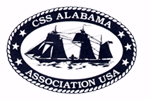
|
|
|
|
|||
|
|
|||
|
|
|||
|
|
|||
|
|
|
|
|
|
|
|
|
|
|
|
Dive Operations Useful Links Special Collections Library at the University of Alabama |
|
|
|
Description of the Vessel Remains Only the unexposed lower hull and portions of the starboard side of the Alabama survive intact. The hull lists approximately 30 degrees to starboard and is oriented perpendicular to the prevailing current pattern. Depth measurements taken by the divers and submersible, precision depth recorder profiles, and observations at the site confirm that sediment consisting of shell hash, pebbles, and sand has accumulated within and around the Alabama to a depth of almost three meters. The major accumulation of material is amidships and is probably a result of the Alabama's machinery and boilers. Amidships the port side of the hull is exposed to the approximate position of the turn of the bilge while the starboard side could survive to the approximate location of the weather deck clamp. Toward the stern the depth of the deposit rapidly decreases to the approximate level of the propeller shaft. At the stern a little less than half of the propeller is exposed along with its brass lifting frame. No evidence of the stem was observed making it difficult to determine the amount of sediment accumulation forward. It is also possible that the hull may not lie on an even keel fore and aft and the amount of surviving structure is considerably less. Very little of the surviving hull structure is exposed at the site. The majority of exposed hull fabric is on the starboard side amidships and adjacent to the boilers. A preliminary site map was prepared by Guerout and the ASAM divers in 1988. To control mapping a baseline was deployed from the propeller in the stern to the approximate location of the stem. Using the baseline as a reference exposed wreck structure and associated material was recorded. The most dominant structural features of the wreck were found to be the boilers and smoke pipe, sections of the hull amidships, and propeller and elevating frame. The partially exposed port boilers each measured approximately 6 meters in length and 3 meters in height. Their shape is rectangular and each is connected to the smoke pipe by a common flue system. Although most of the hull of the Alabama has been destroyed by the elements, sediment accumulating in the vicinity of the steam machinery appears to have preserved a portion of the starboard side of the ship. Adjacent to the boilers the starboard hull could survive up to the level of the weather deck clamp. Although the 30° list documented by divers suggests that more of the starboard side of the ship may be preserved fore and aft of the machinery it does not appear to be much beyond the turn of the bilge. In the stern the exposed propeller and elevating frame confirm that the hull has deteriorated to the level of the propeller shaft and hub. Forward of the machinery perhaps even less hull fabric remains. The stern of the Alabama was identified by the propeller. A single blade of the brass propeller and the top of its lifting frame are exposed above the bottom surface. While no evidence of the bow was identified, portions of two Trotman's Patent anchors confirm its proximity. One anchor lies along the starboard extremity of the hull structure and the second lies to port of the wreck. Development of the site plan also revealed the iron main mast step, a capstan, several sets of bitts, a hawse hole throat, and anchor chain. Three unique toilets were also found in the vicinity of the ship's engineering space. Each contained an English porcelain bowl with a transfer-printed scene inside. Six heavily concreted pieces of ordnance were identified during the investigation. The largest one immediately forward and starboard of the smoke pipe remained associated with its truck. A second cannon was identified immediately forward and to starboard of the propeller. Ten meters forward of the propeller, and starboard of the two brass reinforcing rings from the ship's steering wheels, the muzzle of a third cannon was identified. Immediately aft and to port of the smoke pipe a fourth gun tube rested on the after port boiler. The remaining two guns were found approximately ten meters forward of the smoke pipe. One was located on the approximate centerline of the vessel and the other adjacent to the ship's starboard side. In addition to cannon, the site contains shot, gun truck wheels, and brass tracks for the gun carriages. Click on the titles below for further reading on the C.S.S. Alabama artifact recovery efforts. Artifact Recovery Main Page |
|
|
[ home ][ css alabama ][ news ][ alabama lost ] [ artifact recovery ][ the cruise ][ the crew ][ membership ] |
|||||||